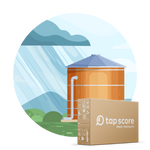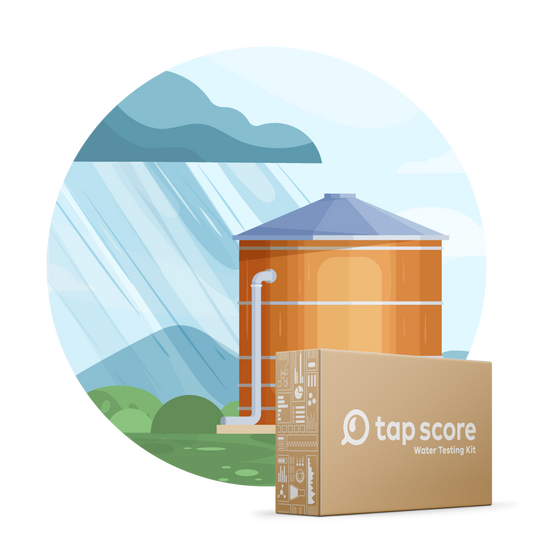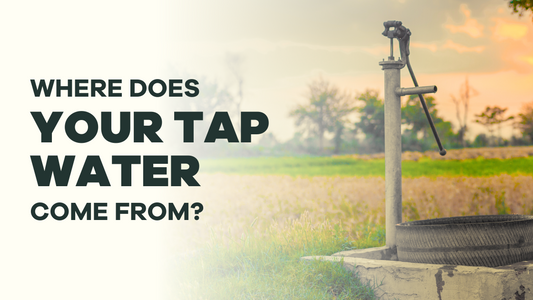
Ultimate Guide to Rainwater Safety
Our blog is written by real experts— not AI. Each guide is carefully reviewed and updated based on the latest research. Plus, with no affiliate links, you can count on unbiased insights you can trust.
From developing countries around the world to areas recovering from natural disasters to survivalists looking to get ahead of the next unforeseen event, rainwater collection is very much still with us. But is rainwater safe to drink?
Whether you’re a prepper or a homesteader, this guide to rainwater safety will help you on your way to ensuring your rainwater is safe for drinking, from contamination prevention to contaminant-specific testing.
What is Rainwater Harvesting?
Rainwater is the water that falls from the sky during a rain or storm event. In a slightly more technical manner, rainwater refers to surface water runoff from a rooftop or other structure after a rainstorm, which moves through pipes or gutters, and collects in a bucket, barrel, cistern, or other storage container.
The collection of rainwater in the above method is known as rainwater harvesting, and is one of the simplest and oldest known methods of water self-supply for households, going back many thousands of years. Traditionally, rainwater has been used for everything from irrigation to cleaning, bathing, and even drinking. In the contemporary United States, rainwater is often used for the watering or irrigation of plants, or for outdoor cleaning.[1] It is also an increasingly popular water source for preppers and survivalists.
Is It Legal to Collect Rainwater?
The legality of rainwater harvesting varies state-by-state. There are no laws, guidelines or restrictions issued by the Federal Government.[2]
Some states impose restrictions on rainwater harvesting, usually motivated by the region’s hydrological cycle. Currently, no states have made rainwater harvesting illegal.
States Where Rainwater Harvesting Is Regulated or Restricted
- Arkansas
- California
- Colorado
- Georgia
- Idaho
- Illinois
- Nevada
- Ohio
- Oregon
- Texas
- Utah
Typically, restrictions are imposed on the quantity of rainwater that can be collected, and how it must be stored. Some states regulate how harvested rainwater may be used. Other forms of regulation may have carried over from old water laws, like in Western states, where some laws governing water rights date back to settlers of the Old West.
Is Rainwater Clean and Drinkable?
Rainwater itself ought to be clean, but in practice, the safety of your rainwater depends on a number of factors. Some aspects outside of your control can potentially contaminate your rainwater, such as the general levels of local air pollution and how frequently it rains in the area.
As for things within your control, rainwater safety depends on your harvesting setup — the state and material of your roof and gutter system, the material and sterility of your storage or collection device, and how you intend to use your rainwater all impact how susceptible your rainwater is to contamination.
How Can I Prevent My Rainwater From Being Contaminated?
If you intend to drink your harvested rainwater, you should consider investing in a dedicated collection and filtration system. The Centers for Disease Control and Prevention (CDC) recommends that any rainwater meant for drinking should be filtered and disinfected, as well as regularly tested. System maintenance is crucial to preventing contamination.[3]
Here is a list of some common sources of contamination and simple recommendations for reducing their potential impacts on rainwater:[8]
Sources of Rainwater Contamination
-
The material and general state of your roof
-
For example, asphalt shingles can leach contaminants and particles, wood shingles can foster mold or algae growth.
-
The material and general state of your gutter system
-
The majority of metal gutters are highly prone to rust and can leach hazardous heavy metals; additionally, plant matter can build up and decay along the gutter route, and animal waste (e.g. bird or rodent droppings) can run off of the roof and/or collect in the gutter system.
-
The material and general sterility of your collection device
-
Many common plastic jugs can contain Bisphenol A (BPA), which is harmful to your health; some jugs are treated with chemicals that can react with disinfectants; some containers may not be airtight.
-
Water stagnation
-
Water that isn’t properly sterilized and sealed can only stand for about 24 hours before it is considered stagnant and unfit to drink
Recommendations and Best Practices for Rainwater Harvesting
-
Replacing the roof of a house is costly and labor-intensive. Nevertheless, corrugated aluminum (when treated) and terracotta are popular choices for harvesters. Where roof replacement is out of reach, your gutter system is your best line of defense.
-
Make sure your gutter system is easy to access for regular maintenance and upkeep.
-
Install water filters from the gutter to the storage container. Particle filters work well for the first stage of rainwater collection.
-
More complex setups can manage overflow by routing water to another, larger water storage location (like a well) and through another round of filtration.
-
Make sure your storage container is of a material that will not leach chemicals into the water and is firmly critter resistant. Some containers also contain antimicrobial technology, although you’ll want to do your research when investigating.
-
Pay attention to how long your water is stored:
-
For untreated water intended for plants, you’ll want to empty your containers regularly. (The CDC recommends 10 days, but one week—5-7 days—is a safer bet.) It’s especially important to keep unpurified water out of the sunlight and in motion as frequently as possible.
-
Additionally, for vegetable gardens, only pour untreated rainwater into the soil, never directly onto the plant itself.[4]
-
For water you intend to drink or cook with (which should be disinfected), proper storing conditions (cool, dark places like cellars or basements) and the material of the container (airtight, resistant to critters or rodents) are key to long-term storage.
Most importantly, test your water regularly.
Can Rainwater Contain Lead and Heavy Metals?
Studies showing atmospheric lead particles falling within rain drops have proved inconclusive. However, lead—and other heavy metals such as cadmium, copper, zinc or chromium—can be a part of your roof, gutter, or piping setup.[5] If you suspect lead or other heavy metals could be coming in contact with your harvested rainwater, you should test it.
Can Rainwater Contain Bacteria Like Coliform and E. coli?
Absolutely. You should test for a full range of pathogens, including viruses and parasites, as they are the most common source of waterborne illness and highly common in untreated rainwater.
Can Rainwater Contain PFAS?
According to recent studies, a number of different PFAS chemicals have been detected in rainwater around the world. Additionally, PFAS could be a material component of your harvesting system. PFAS-specific lab testing is the only way to find out if your rainwater contains these “forever chemicals.”
Can Rainwater Contain BPA?
Rainwater itself is not known to contain bisphenol A (BPA). However, your storage container—if it is not made from BPA-free plastic—may leach BPA into your rainwater. Plastic used in roofing and gutter networks can also leach BPA into your supply. There are BPA (and BPF, a BPA alternative)-specific tests available that can help if you’re unsure whether or not BPA-containing plastic is a part of your harvesting setup.
Can Rainwater Contain VOCs?
Trace amounts of volatile organic compounds (VOCs) can travel in rainwater in areas directly near industrial output. Primarily, however, they are found in refined organic products such as paints and solvents. Therefore, they can be a part of your harvesting system. Be sure to use only products approved for potable water use or products otherwise deemed food safe.[6]
Can Rainwater Contain Pesticides?
Depending on your location, crop-spraying from aircraft can coat your roof with harmful pesticides. If you live near any farmland, it is recommended you test your rainwater for pesticides.
Should I Use a Brita Filter For Rainwater?
Simply put, no. While Brita filters may help make tap water (which is treated to begin with) more palatable, they will not remove some worrisome contaminants that can be found in rainwater such as waterborne pathogens and certain heavy metals like chromium. Brita specifically states on its website that its products are meant to be used with treated, disinfected water which makes them unfit for rainwater treatment. For more insight into Brita filters, check out this post.
Should I Use a ZeroWater Filter For Rainwater?
It’s not recommended. One of ZeroWater pitchers’ main selling points is their claim to remove all total dissolved solids (TDS) from water. While this may be true, the removal of TDS doesn’t give any information on the removal of various other contaminants that may be present in rainwater, like waterborne pathogens and certain heavy metals. Like Brita, ZeroWater specifically states on its website that its products are meant to be used with treated, disinfected water. Furthermore, ZeroWater filters (1 per pitcher/tank) are more costly to replace than other filter pitchers, and will give you shorter longevity if you haven’t taken the proper preventative measures to purify your rainwater before it reaches the pitcher. Lastly—especially from a prepper’s perspective—a stockpile of water that has 0 TDS will impact health negatively over the long term, filtering out healthy minerals and naturally-occurring electrolytes needed for proper hydration. It may also have an unpleasant flavor as some of the minerals that comprise TDS (below certain concentrations) typically lead to better tasting water.
Should I Use a Berkey Filter For Rainwater?
Berkey filtration systems claim to be effective at filtering out an impressively wide range of contaminants, including bacteria and viruses. In particular, the Big Berkey filters stand out for larger volume setups. But while the purification technology used in the Berkey system should stand up to the majority of contaminants discussed in this article, regular maintenance is key. Furthermore, Berkeys take time to filter your water, and the dirtier the water the more taxing on the system. In addition to the general upkeep your harvesting setup requires and regular maintenance of your Berkey filters, it’s a good idea to put your rainwater through at least one round of particle filtration (to filter out matter or debris that can impair a Berkey’s filtration performance) and chlorination (to catch bacteria or viruses before they reach your Berkey where they can remain and proliferate on the filters themselves) to improve overall performance.
Will Boiling Rainwater Make It Safe to Drink?
Boiling water only kills pathogens, it does not remove most chemical contaminants that may enter the water through your roof, gutter network, or storage container.[7] In fact, boiling water can increase the concentrations of heavy metals and some other chemicals and is generally not recommended as a water treatment technique except in certain emergency situations.
What Is the Best Way To Test Rainwater Quality?
Even if you’ve taken the proper precautions to get your rainwater up to drinking level, you’ll want to add regular testing to your maintenance checklist. If you live near a city, factory, or industrial farmland, you’ll want to have your water lab tested for a range of chemicals and other contaminants that could be a part of the ecology of the area. Lab testing is the only way to test accurately for things like nitrates, pesticides, VOCs, solvents, PFAS, etc.
But even if you don’t live near large-scale manmade operations, it’s a good idea to have your harvested rainwater lab tested. The results will provide you with an accurate, baseline picture of your water’s quality and help certify your setup is working properly.
Tap Score’s Rainwater Tests
Essential Rainwater Test
Baseline water quality test for rainwater safety in a catchment or other harvesting system.
Advanced Rainwater Test
Ideal water quality test to ensure correct setup of rainwater catchment system, and for those noticing unpleasant tastes or smells in rainwater.
Essential Rainwater Test tests for a wide range of analytes, including bacteria (total coliform and E. coli), fertilizers (nitrates and nitrites) and well over a dozen heavy metals (including arsenic, chromium, copper, lead, and mercury). This test provides a baseline glimpse of your harvesting system’s performance and can be your first step in troubleshooting harvested rainwater that tastes metallic, bitter, or rusty, smells moldy or mildew-like, or produces biofilm buildup or microbial growth somewhere along the line.
The Advanced Rainwater Test tests for over twice the amount of analytes found in the Essential, adding disinfection byproducts, VOCs, and oil, gas, and BTEX chemicals to those found in the test listed above. The Advanced kit is ideal for harvesting systems featuring plastic, PVC, HDPE, or PEX synthetics, and gives you a comprehensive look at your harvesting system’s overall performance. If the presence of sweet, plastic, or chemical-like flavor is in your water, the advanced kit is a good way to test for its sources. Additionally, this is the right test for you if you’ve made any major alterations or additions to your harvesting system.
Remember, if you have any comments, questions or concerns, don’t hesitate to reach out to our team of water scientists and experts! They’re always available for your water needs. Drop us a line at support@mytapscore.com.












